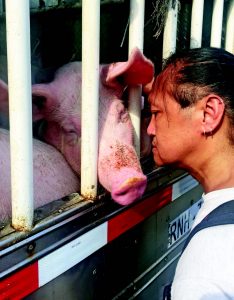“Meat is murder” — animal rights activists around the world expose the cruelty towards animals slaughtered for food under this tagline. What they may not have immediately realized is how recent research may give these three words a whole new meaning.
Violence begets Violence
Communities tend to experience an uptick in crime once a slaughterhouse moves in. According to a 2009 study by Amy Fitzgerald and her team, the number of employees in a slaughterhouse correlated to the number of arrests made due to rape, other sex offenses, and violent crimes.

She believed that the inherently violent nature of their work could explain this curious phenomenon.
The empirical analysis published by Fitgerald and colleagues mentioned the “jungle” hypothesis, formulated by journalist- novelist Upton Sinclair over a hundred years ago. In his 1906 novel, Sinclair criticized the existence of stockyard slaughterhouses in Chicago, calling it a jungle. He wrote about the horrible work and living conditions of the many workers employed by the slaughterhouse complex.
Sinclair went on to theorize that earning one’s keep by killing animals and dismembering them might have contributed to the many brawls started by slaughterhouse employees. Citing Sinclair’s work, Fitzgerald believed the “jungle” effect of a slaughterhouse didn’t stay confined within its walls, instead spilling over and contaminating entire communities.
Meat and Aggression
Many abattoir workers claimed they became desensitized even to human suffering, leading to a propensity for cruelty towards others, reported Emma Richards and colleagues in a 2013 article in Society & Animals.
In an interview, sociologist Dr. Nik Taylor of Flinders University explained that having a positive attitude towards animals was associated with lower aggression levels. Meat workers, on the other hand, had aggression scores equaling those of people in prisons.
This appeared in Animal Scene magazine’s August 2018 issue.






